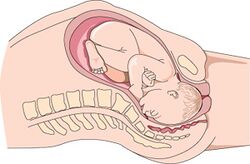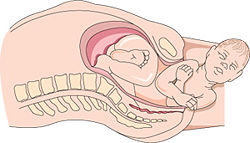Childbirth: Difference between revisions
imported>Ro Thorpe m (sentence case for headings) |
imported>Howard C. Berkowitz (Formatting: first,, the metadata does not go in the main page, only {{subpages}}. I cleared whitepace and added links.) |
||
| Line 1: | Line 1: | ||
{{subpages}} | |||
{{Image|Labor-pelvis.jpg|right|250px|Most babies enter the [[birth canal]] facing sideways and the head turns face down.}} | {{Image|Labor-pelvis.jpg|right|250px|Most babies enter the [[birth canal]] facing sideways and the head turns face down.}} | ||
'''Childbirth''', or labor and delivery, is when a woman gives birth to a [[baby]]. Labor has three stages. The first stage of labor has two phases: latent and active. The second stage of labor is when the baby is born while the third stage of labor is when the placenta is delivered. | '''Childbirth''', or labor and delivery, is when a woman gives birth to a [[baby]]. Labor has three stages. The first stage of labor has two phases: latent and active. The second stage of labor is when the baby is born while the third stage of labor is when the placenta is delivered. | ||
== First stage of labor == | == First stage of labor == | ||
Irregular contractions are felt during the latent phase of labor. The contractions will slowly become more regular and pain is minimal. The [[cervix]] will dilate and efface up to 4 [[centimeter]]s during the latent phase of labor. First time mothers will on average labor 8 hours during the latent phase. Mothers who have borne previous children typically have shorter labor during the latent phase. Towards the end of this stage a woman will enter the transition phase. During this part of labor the cervix will continue to dilate to 10 centimeters. This is probably the most painful part of the labor process. | Irregular contractions are felt during the latent phase of labor. The contractions will slowly become more regular and pain is minimal. The [[cervix]] will dilate and efface up to 4 [[centimeter]]s during the latent phase of labor. First time mothers will on average labor 8 hours during the latent phase. Mothers who have borne previous children typically have shorter labor during the latent phase. Towards the end of this stage a woman will enter the transition phase. During this part of labor the cervix will continue to dilate to 10 centimeters. This is probably the most painful part of the labor process. | ||
== Second stage of labor == | == Second stage of labor == | ||
The cervix is fully dilated and the woman begins to push to deliver the baby. This phase of labor can last up to two hours. The baby is delivered at the end of the second stage of labor. The [[umbilical cord]] is cut by the doctor once the delivery is finished.{{Image|Labor-head.jpg|right|250px|The head emerging from the birth canal.}} | The cervix is fully dilated and the woman begins to push to deliver the baby. This phase of labor can last up to two hours. The baby is delivered at the end of the second stage of labor. The [[umbilical cord]] is cut by the doctor once the delivery is finished.{{Image|Labor-head.jpg|right|250px|The head emerging from the birth canal.}} | ||
== Third stage of labor == | == Third stage of labor == | ||
The [[placenta]] is delivered during the third stage of labor. Usually this phase of labor takes between 5 to 20 minutes. | The [[placenta]] is delivered during the third stage of labor. Usually this phase of labor takes between 5 to 20 minutes. | ||
== Cervical dilation == | == Cervical dilation == | ||
Measurement of the cervix is recorded from 0 to 10 centimeters. The cervix is considered complete when it reaches 10 centimeters. | Measurement of the cervix is recorded from 0 to 10 centimeters. The cervix is considered complete when it reaches 10 centimeters. | ||
== Effacement == | == Effacement == | ||
The cervix shortens in preparation for birth. The normal uneffaced average cervical length is between 3.5 to 4.0 centimeters. | The cervix shortens in preparation for birth. The normal uneffaced average cervical length is between 3.5 to 4.0 centimeters. | ||
== Station == | == Station == | ||
Station is measured by where the baby's head is located in reference to the woman's ischial spines. Measurements above the ischial spines are reported as -1 to -5. Once the baby's head engages into the pelvis, or at 0 station, the baby's placement within the birth canal will be written in positive numbers. The numbers for the positive station are written as +1 to +5. | Station is measured by where the baby's head is located in reference to the woman's ischial spines. Measurements above the ischial spines are reported as -1 to -5. Once the baby's head engages into the pelvis, or at 0 station, the baby's placement within the birth canal will be written in positive numbers. The numbers for the positive station are written as +1 to +5. | ||
== Episiotomy == | == Episiotomy == | ||
A small incision, or cut, used to enlarge the vaginal opening. The cut is made from the vaginal to anus. The person performing the delivery sutures the area once the delivery is finished. This is not always done during a vaginal delivery, and, indeed, is quite controversial. | |||
A small incision, or cut, used to enlarge the vaginal opening. The cut is made from the vaginal to anus. The | |||
== Cesarean section == | == Cesarean section == | ||
The cesarean is when a baby is surgically removed from the uterus. Most cesarean section usually takes up to an hour to complete. The surgeon normally makes two cuts in the lower abdomen before making an incision in the uterus. The baby is removed from the uterus and the umbilical cord is cut. | The cesarean is when a baby is surgically removed from the uterus. Most cesarean section usually takes up to an hour to complete. The surgeon normally makes two cuts in the lower abdomen before making an incision in the uterus. The baby is removed from the uterus and the umbilical cord is cut. | ||
Revision as of 19:39, 3 August 2010

Most babies enter the birth canal facing sideways and the head turns face down.
Childbirth, or labor and delivery, is when a woman gives birth to a baby. Labor has three stages. The first stage of labor has two phases: latent and active. The second stage of labor is when the baby is born while the third stage of labor is when the placenta is delivered.
First stage of labor
Irregular contractions are felt during the latent phase of labor. The contractions will slowly become more regular and pain is minimal. The cervix will dilate and efface up to 4 centimeters during the latent phase of labor. First time mothers will on average labor 8 hours during the latent phase. Mothers who have borne previous children typically have shorter labor during the latent phase. Towards the end of this stage a woman will enter the transition phase. During this part of labor the cervix will continue to dilate to 10 centimeters. This is probably the most painful part of the labor process.
Second stage of labor
The cervix is fully dilated and the woman begins to push to deliver the baby. This phase of labor can last up to two hours. The baby is delivered at the end of the second stage of labor. The umbilical cord is cut by the doctor once the delivery is finished.
Third stage of labor
The placenta is delivered during the third stage of labor. Usually this phase of labor takes between 5 to 20 minutes.
Cervical dilation
Measurement of the cervix is recorded from 0 to 10 centimeters. The cervix is considered complete when it reaches 10 centimeters.
Effacement
The cervix shortens in preparation for birth. The normal uneffaced average cervical length is between 3.5 to 4.0 centimeters.
Station
Station is measured by where the baby's head is located in reference to the woman's ischial spines. Measurements above the ischial spines are reported as -1 to -5. Once the baby's head engages into the pelvis, or at 0 station, the baby's placement within the birth canal will be written in positive numbers. The numbers for the positive station are written as +1 to +5.
Episiotomy
A small incision, or cut, used to enlarge the vaginal opening. The cut is made from the vaginal to anus. The person performing the delivery sutures the area once the delivery is finished. This is not always done during a vaginal delivery, and, indeed, is quite controversial.
Cesarean section
The cesarean is when a baby is surgically removed from the uterus. Most cesarean section usually takes up to an hour to complete. The surgeon normally makes two cuts in the lower abdomen before making an incision in the uterus. The baby is removed from the uterus and the umbilical cord is cut.
